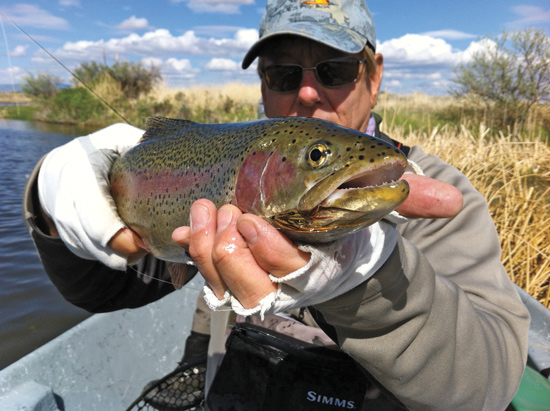July 15, 2013
By Charlie Craven
[caption id="attachment_14856" align="alignright" width="330" caption="The unweighted Platte River Spider lets you fish the shallow, shoreline feeding zones where heavier flies often hang up. Photo: Dave Cook"] [/caption]
[/caption]
It's no secret that I like pretty flies. I'm well aware that ugly flies catch fish too, but a fly that oozes elegance just seems to build confidence for me, and it seems each year I turn into more and more of a classy fly snob.
Chris Schrantz's Platte River Spider may just be the prettiest modern trout fly out there, which is no small feat these days. Schrantz is an avid steelheader and a master carpenter, both characteristics that shine through in his patterns. Schrantz has coupled a Gartside-esque soft-hackle streamer with the classic Platte River Special to create a beautiful, easy-to-cast, breathing, flowing, trout-catching work of art.
One of the most compelling aspects of the Platte River Spider is its lack of a traditional body of any sort on the hook shank. The marabou collar forms the body of the fly, yet the hook shank remains bare.
On the 3X long Tiemco 200R, the hook bend rides near the back of the marabou, waiting to reach out and grab any lip that gets near it, while allowing the fly to undulate and breathe unlike anything tied to a rigid shank.
Mixing a warm yellow marabou feather with dark brown creates a striated profile that rises and falls with each pulse of the line, while the paired yellow and furnace neck hackle wing completes the silhouette and helps the fly track straight on the swing and retrieve.
I am generally not a fan of unweighted streamer patterns, and when I questioned Schrantz as to why this fly is tied with no additional weight he explained that he likes to fish it on a long sinking tip, or full-sinking line, sometimes on a two-hander or switch rod, to better enjoy the casting aspect of a day on the water. I have to admit, he's got a point. My right shoulder can attest to the workout you get from throwing heavily weighted flies for several hours, especially when the fishing is hot and fish-greed creeps in.
Schrantz often fishes the large and meandering North Platte River, where his sinking-tip techniques really shine. I have found that a lightly weighted fly is hard to keep down in the water column, however,
particularly when pounding banks on faster moving rivers where a sinking-tip line doesn't have time to affect the fly. In this case I pair the Spider with a heavier weighted fly in tandem—most often a lead-eye Motor Oil Bugger—with the Spider on an 18" 0X dropper. I tie my streamers together eye to eye, to keep the hook bend free of the dropper line, and let each fly wiggle and dance independently of the other.
This weighted/unweighted combination has been particularly effective for me along shelved banks. Dropping the light Spider tight to the bank, and the heavier fly just on the edge of the deeper shelf lets me cover both ambush points, and keeps me from hanging the heavier fly up in the sticks and rocks along the edges. I've often had fish come out of the deep to chase the bigger, darker pattern only to wallop the Spider as soon as it appears.
If there is one undesirable trait in Schrantz's pattern it is that fish will sometimes suck it straight down their pipe, leaving only the hook eye showing in their throat. For this reason I debarb these flies at the vise and in some cases, I even tie them with a large tungsten bead hidden behind the marabou collar. My theory is that this fly presents a large silhouette to the fish but it is really very light and collapsible. The lightly dressed fly is simply much smaller than anticipated, and gets sucked down much easier than a larger fly. Adding the tungsten bead adds just enough weight to keep the fish from dangerously inhaling it, but not so much as to kill the action of the pattern.
My streamer box is overflowing with large, dark, heavy, and articulated patterns that all have their time and place these days, but the Platte River Spider, in its austere glory, has earned a well-deserved spot in my stash, one that is filled by no other pattern, it seems.
This uniquely beautiful and fun-to-tie pattern has often made me rethink my approach to streamer fishing, and while I will never give up the traditional box of nastiness I cart around in the boat, my Platte River Spiders will always have a home.
Charlie Craven co-owns Charlie's Fly Box in Arvada, Colorado, and is the author of Charlie's Fly Box (Stackpole Books, 2011). He is also the featured tier in the iPhone app FlyBench, available in the iTunes store.
[imo-slideshow gallery=91]

